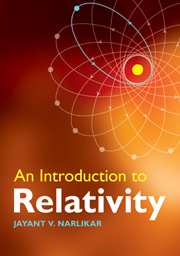Book contents
- Frontmatter
- Contents
- Preface
- 1 The special theory of relativity
- 2 From the special to the general theory of relativity
- 3 Vectors and tensors
- 4 Covariant differentiation
- 5 Curvature of spacetime
- 6 Spacetime symmetries
- 7 Physics in curved spacetime
- 8 Einstein's equations
- 9 The Schwarzschild solution
- 10 Experimental tests of general relativity
- 11 Gravitational radiation
- 12 Relativistic astrophysics
- 13 Black holes
- 14 The expanding Universe
- 15 Friedmann models
- 16 The early Universe
- 17 Observational cosmology
- 18 Beyond relativity
- References
- Index
10 - Experimental tests of general relativity
Published online by Cambridge University Press: 05 June 2012
- Frontmatter
- Contents
- Preface
- 1 The special theory of relativity
- 2 From the special to the general theory of relativity
- 3 Vectors and tensors
- 4 Covariant differentiation
- 5 Curvature of spacetime
- 6 Spacetime symmetries
- 7 Physics in curved spacetime
- 8 Einstein's equations
- 9 The Schwarzschild solution
- 10 Experimental tests of general relativity
- 11 Gravitational radiation
- 12 Relativistic astrophysics
- 13 Black holes
- 14 The expanding Universe
- 15 Friedmann models
- 16 The early Universe
- 17 Observational cosmology
- 18 Beyond relativity
- References
- Index
Summary
Introduction
The general theory of relativity, like any other physical theory, must submit itself for experimental verification. It started with a disadvantage in that it was competing with a well-established paradigm, viz. the Newtonian laws of motion and gravitation. Any test that could be designed for testing general relativity had at the same time to show ways of distinguishing its predictions from those of the Newtonian framework. Here the situation has been different from the case of special relativity. Many laboratory tests have been designed (see some in the opening chapter) to study the dynamics of fast-moving particles. For, in this case, the crucial factor γ, distinguishing relativity from Newtonian dynamics, is significantly different from unity. For really testing general relativity we need situations of strong gravitational fields that cannot be arranged in a terrestrial laboratory. The differences from Newtonian predictions can and do exist in relatively weak fields, however, provided that we look at astronomical situations. Therefore astronomical tests have figured prominently in establishing the general theory.
In the early days Einstein proposed three tests, which are known as the classical tests of general relativity. More tests emerged in later years, although their number is still small. In this chapter we will disuss both classes of tests. All except one require an astronomical setting.
To place matters in proper perspective, let us see how ‘strong’ or ‘weak’ the Earth's gravitational field is at its maximum, i.e., on the surface of the Earth.
- Type
- Chapter
- Information
- An Introduction to Relativity , pp. 143 - 161Publisher: Cambridge University PressPrint publication year: 2010



